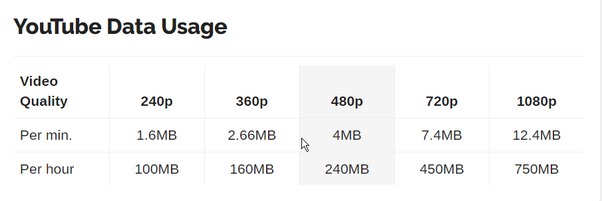- 100GB data (or 100,000MB) is functionally almost unlimited.
- Even with video streamed in high quality you could manage around 30 hours a month (depending on the source).
- Chances are you don’t need that much, or would be fine with medium quality, which gives you a lot more.
En effet, How many hours of streaming is 100GB? Streaming in standard definition will give you around 140 hours per month with 100 GB. While that’s almost 5 hours a day, it’s possible to reach the limit if you have multiple people in your household streaming content regularly.
Is 1GB data enough for a month? With your 1GB of data, you’ll be able to browse the internet for approximately 12 hours per month, to stream 200 songs online or to watch 2 hours of online video in standard definition. In this article, we’ll discuss what you can do with 1GB of data and how long you can expect your 1GB allowance to last for.
Table des matières
How long will 100GB data last?
Mobile Data Limits. A 100GB data plan will allow you to browse the internet for around 1200 hours, to stream 20,000 songs or to watch 200 hours of standard-definition video.
What uses the most data? The apps that use the most data typically are the apps that you use the most. For a lot of people, that’s Facebook, Instagram, Netflix, Snapchat, Spotify, Twitter and YouTube. If you use any of these apps daily, change these settings to reduce how much data they use.
Is 100GB data enough for 1 month?
Your data should normally refresh every month or 30 days, so theoretically you have an average of 720 hours to fill a month. 100GB can last almost non-stop for the entire month, so you’d never have to connect to Wi-Fi if you didn’t want to.
Is 200 GB enough for a month?
If you live by yourself or with one other person, you may be able to swing 200GB per month. Check out the table below to see what each amount translates to in terms of video streaming, music streaming, gaming and more, split among each activity.
Is Netflix true 4K?
In terms of video quality, Netflix streams 4K at 2160p, which is good news. There’s no lesser term when it comes to 4K, or UHD, as there was with some providers of HD video who only broadcast in upscaled 720p at 1080i.
How many GB is a 2 hour movie on Netflix?
This means you’ll use around 2 GB to stream a two-hour SD movie, 6 GB to stream the HD version or 14 GB for the 4K stream. A half-hour TV show would be 500 MB for the SD version, 1.5 GB for the HD version or 3.5 GB for 4K.
Why is Netflix so blurry?
If you are experiencing blurry video or low video quality when streaming Netflix, it could be caused by your Internet connection or a setting in your Netflix account. Your connection may be affected by other online activity on your network, such as online gaming, file sharing, or other video streaming.
Does Netflix have 8K?
Ideally, the TV’s internal apps for Netflix, Amazon Prime Video and the rest will be 8K compatible. You’d think that’d be a given, but it wasn’t in the early days of 4K. Further, there’s no 8K content from any major streaming service available yet.
Why should I not watch Netflix?
In this article we examine the disadvantages of Netflix.
- Limited Regional Selections.
- An Outdated Library. …
- Internet Requirements. …
- Data Cap Consumption. …
- No Ownership of Media. …
- Subscription Value. …
- Loss of Channel Surfing.
How long will 100GB streaming?
With your 100GB of data, you’ll be able to browse the internet for approximately 1200 hours per month, to stream 20,000 songs online or to watch 200 hours of online video in standard definition.
Is 1GB data enough for a day?
Stream about 7 hours of music per gigabyte at the highest quality setting. Normal and low-quality settings are also available. Listen to almost 35 hours of music for 1GB of data.
Is Netflix 4K really 4K?
In terms of video quality, Netflix streams 4K at 2160p, which is good news. There’s no lesser term when it comes to 4K, or UHD, as there was with some providers of HD video who only broadcast in upscaled 720p at 1080i.
Why is it called 4K?
Why is it called 4K? It’s called 4K because the images are around 4,000 pixels wide. And before you ask, yes, the industry named 1080 resolution after image height, but named 4K after image width. For extra added fun, you also might hear this resolution referred to as 2160p.
Is Ultra HD the same as 4K?
For the display market, UHD means 3840×2160 (exactly four times HD), and 4K is often used interchangeably to refer to that same resolution. For the digital cinema market, however, 4K means 4096×2160, or 256 pixels wider than UHD.
Is 2K better than 4K?
Also, 4K is four times the 2K standard, and therefore has a resolution of 4096 x 2160. UHD, on the other hand, is more for consumer TV products.
Is 4K better than 1080p?
The jump to 4K resolution is an effective quadrupling of 1080p. At 3840 pixels across and 2160 up and down, 4K jams four times as much information into the screen, with a whopping total of over 8 million pixels.








